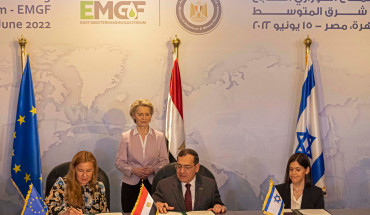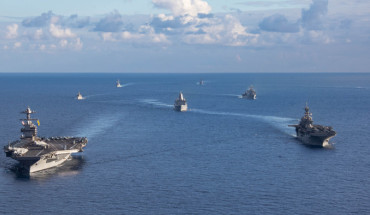Iran’s political culture is most compatible with a proactive foreign policy based on “patriotic cosmopolitanism,” a kind of doctrine with two apparently antithetical components: the idea of global citizenship, regardless of people’s political affiliation; but also political committment to sustain one’s own values — in this case, Iranian values. Ideally, this formulation should appeal to religious intellectuals and pro-Mossadeq nationalists. But in reality, contemporary Iran has been caught between two extreme tendencies in its approach to international politics — “repulsive assertivism” and “primordial globalism.” Repulsive assertivism is an ideological tendency driven by negative emotions to expunge the vestiges of a past adverse status quo — in this case, the humiliations imposed upon Iran by great powers in last two centuries — in a bid to once again become a viable and honorable polity. In this respect assertiveness functions primarily to express emotion and perhaps also to elicit similar emotions among others (in this instance Muslims and other disgruntled groups) against foreign intruders. Primordial globalism is a long-standing approach to mobilizing Muslims around the world to support the Islamic republic’s cause and integrity against the threat of Western-led globalism. In turn, these latter cultures have been undermined by the idealistic imperatives of patriotic cosmopolitanism. Based upon a survey by the BBC, 85% of Iranians express a cosmopilitan passion, and feel that they are citizens in a global civil society.
Essentially, then, contemporary Iranian political culture as it relates to Iran’s approach to the Westphalian international system is a “push-pull” dynamic between these two competing tendencies. On one end of the spectrum lies the “repulsive assertivist” tendency, which dispenses with Iran’s role as a geopolitical bridge in a realist bid to safeguard Iran’s independence against foreign incursions. On the other end lies “primordial globalism,” which is of more recent vintage and embodies the hope for reviving either Iranian and/or Islamic empires. It is within this mixed cultural context that the real strategic outlooks of contemporary Iran have been devised.
Culture and Historiography of Iranian Approaches to International Relations
Iran’s first approach to the Westphalian international system arose from its epoch-making defeats by Russia and Great Britain in the 19th century. As a result of these defeats, the “push-pull” mechanism in Iran appeared for the first time. Chancellor Ghaem-Magham Farahani[1] embraced a “cognitive” approach to the defeats, while Muhammad Shah adopted a “primordial” (or ethnic foundationalist) reaction. Whereas the cognitive approach of Ghaem Magham was a deliberate approach based upon the national interest and values of Iran, the primordial (foundationalist) tendency of Muhammad Shah was an instinctive impulse, driven more by his tribal affiliations.
As time passed, other “pushes” complicated the picture. Rational choice of a balance-of-power between European Great Powers and the primordial surrealism of the clerical gentry defined in terms of anti-Russian fundamentalism also surfaced. In the process of push-pull mechanisms, however, the balance-of-power principle of “divide and rule” by Great Britain and Russia prevailed. Muhammad Shah[2] was enticed to kill Ghaem Magham in 1835. Hence, Iran’s approach toward the Westphalian international system has been influenced by primordial culture.
Such a push-pull phenomenon has recurred many times in Iran. In a matter of two decades, such a push-pull and its tragic consequences once again resurfaced in Iran’s approach to international relations. In this case, yet again the cognitive approach of Amir Kabir[3] was truncated by the ethnic foundationalism of Nasser-ed-Din Shah.[4] This time British machinations provoked both clerical fundamentalism and the ethnic foundationalism of Nasser-ed-Din Shah against the cognitive approach of Amir Kabir. Similar to the case of Ghaem Magham, foreign machinations enticed Nasser-ed-Din Shah to kill Amir Kabir in 1852.
Due to these experiences, the monarchs of the Pahlavi dynasty tried to incorporate Iran into the modern international system, justifying their approach with national interests, revolving primarily around the bridge geopolitics of Iran’s location and then of its oil. A succession of prime ministers assisted the Qajar and then Pahlavi monarchs in this effort: Mirza Hossein Khan Sepah-salar (appointed in 1871), Mohammad Ali Forughi (appointed in 1925, 1933, and 1941), Ahmad Ghavam (last appointed in 1952).
This approach received harsh criticism primarily from the nationalists gathering around Prime Minister Muhammad Mossadeq. Of course, the humiliating invasion of the Allied forces during the Second World War, ignoring Reza Shah’s policy of neutrality, was a contributing factor. The inadvertent opening up of the polity of Iran was another factor. Against these favorable circumstances, Mossadeq attempted the first “velvet revolution” in Iran in 1950. Due to his legal education and moral attachment to Iran, he worked hard to make Iran’s international politics an extension of its domestic needs. This time, the strategic calculations of Britain and the United States led to the US-engineered coup against his legitimate government. The Soviet Union betrayed him as well.
As a result, the second Pahlavi monarch, Muhammad Reza Shah Pahlavi, and his subservient prime ministers attempted to resign Iran to a proxy role in international relations. Such an inverted approach to politics — making domestic politics a continuum of international politics — required some due changes in Iran’s domestic sphere. The secularization of politics and capitulation were ratified and implemented in the 1960s. This infuriated the clerics not only against the regime but also against the international system and order. The Islamic Revolution was a reaction to such Westphalian politics.
The Islamic revolution exhibits both change and continuity. The primordial overarch remains constant, but its locus has changed from ethnic foundationalism to religious fundamentalism. In the process, however, after the cognitive approach of Prime Minister Mehdi Bazargan (1979) and America’s allowing the Shah’s entry into the US, the way for the fundamentalist approach was paved. After the embattled President Bani Sadr, Muhammad ‘Ali Rajai’s fundamentalism (1981) and Prime Minister Mir-Hossein Mousavi’s mixed moral-fundamentalist approach took effect. In reaction to their policies, for 16 years, Hashemi Rafsanjani attempted a modified pragmatic detente (1989-1997) and Muhammad Khatami attempted a triadic and inconsistent coexistence-adjunct coalition-global cooperation. President Bill Clinton’s imposed sanctions betrayed Rafsanjani, and George W. Bush’s naming of Iran as a member of the “Axis of Evil” betrayed the latter. Since 2005, Mahmud Ahmadinejad has pioneered a primordial surrealist campaign against the Pax Americana international system and order. His primordial surrealist campaign is a pragmatic foreign policy targeted to undermine Western globalism and hegemony by capitalizing on the already charged emotions (pan-Muslim solidarity and hate for the hostile West) of Muslims around the world. Khatami and Rafsanjani shifted their campaign in favor of preventive realism, in their hope for self-defense and resistance against the West.
The lasting popularity of Mossadeq, the more or less widening distance of Mousavi and Khatami in contrast to the tarnished images of rationalists such as Mohammad Ali Forughi and Jamshid Amouzegar, and the waning popularity of surrealism explains Iran’s two-tiered international politics for normal and crisis circumstances.
The Impact of Moral Culture on the International Politics of Iran
Thanks to the criticism leveled against the trials and errors of the various appointed or elected officials in entangling in the pushes and pulls of polar positions of anarchic assertivism to primordial confrontation or in-between modified positions, Iran has come to its own approach to international relations. Anarchic assertivism is a part of self-defense policy of Iran to undermine the Pax Americana order by asserting that Iran is an independent state, with differing strategic interests and values, and against the conformist measures imposed by the Pax Americana order. In case the US decides to push for confrontation to defeat Iran’s assertive campaign, then the only remaining option for Iran is to opt to capitalize on the primordial values and the divided surrealist (love-hate) emotions of Muslims. By lumping both strategic needs and cultural tendencies, two alternative ideational approaches are devised; the positive and negative ranges. Each of these ranges has two normal and crisis situations. The normal positive range revolves around moral culture and the negative range revolves around cognitive culture. The best case scenario is located in the moral culture context; and the second best case scenario is located within the cognitive context. Each of these first and second best options include two scenarios. In sum, these four strategies reflect the proactive approach of Iran to international relations. The best case scenario for Iran is operationally defined in terms of two policies: either “Adjunct Coalitions” or “Cooperation on Global Issues.” This tier of Iran’s proactive policy is based upon a win-win policy for all and in accordance with Iran’s status as a geopolitical bridge. In case the great powers decide to use Iran’s geopolitical status against its will, then Iran will opt for the alternative tier of second best scenario. This scenario is operationally defined in terms of self-defense or resistance. Under exigencies, Iran will either shift to a rational choice culture defined in terms of “repulsive assertivism,” or instead to “primordial globalism,” at either extreme poles of the following diagram. The diagram above depicts the correlation between the culture and international relations approaches of Iran.
[1]. Iranian Prime Minister from 1834-5.
[2]. Shah of Persia, 1834-48.
[3]. Prime Minister from 1848-51.
[4]. Shah of Persia, 1848-96.
The Middle East Institute (MEI) is an independent, non-partisan, non-for-profit, educational organization. It does not engage in advocacy and its scholars’ opinions are their own. MEI welcomes financial donations, but retains sole editorial control over its work and its publications reflect only the authors’ views. For a listing of MEI donors, please click here.













